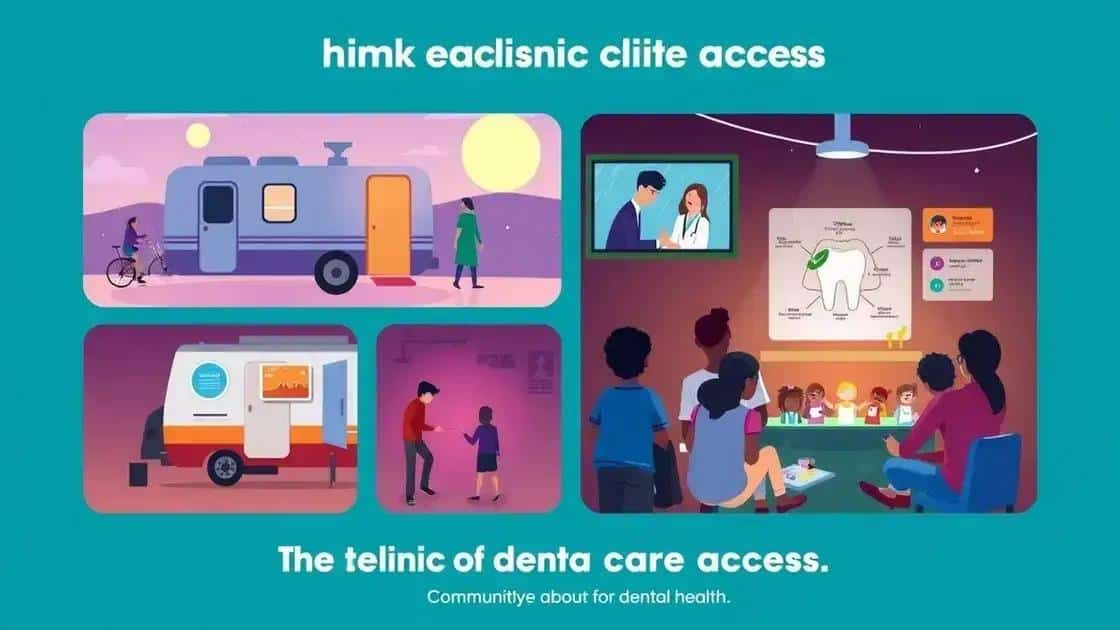Expanded access to dental care for children: a vital need

Expanded access to dental care for children is essential for ensuring their overall health, overcoming barriers like financial constraints, and implementing successful community programs and telehealth initiatives.
Expanded access to dental care for children is a pressing issue that many families face. Have you ever wondered how accessible dental care truly is for our kids? Let’s dive in and explore the challenges and solutions together.
Understanding the current state of dental care access
Understanding the current state of dental care access is essential for improving health outcomes, especially for children. Many families, particularly in underserved areas, find it challenging to obtain necessary dental services.
Current Challenges
Access to dental care is hindered by several factors. One significant barrier is financial constraints, which can prevent families from seeking regular dental checkups. Additionally, there are limited dental providers in certain regions, leading to long wait times.
Key Barriers to Access
- Cost of dental services often leads families to postpone care.
- Lack of insurance coverage contributes to reduced access.
- Geographic limitations leave some communities without local dental clinics.
- Transportation issues can deter families from attending appointments.
Moreover, awareness of dental health is a recurring issue. Many parents may not understand the importance of starting dental visits early, which can lead to untreated issues that affect overall well-being. Education about dental health is vital in promoting preventive care among families.
Programs aimed at improving access to dental care are becoming more prevalent. By focusing on outreach and education, these programs help bridge the gap. Additionally, tele-dentistry is emerging as an innovative solution to reach families who may not have traditional access to care.
As we explore these factors further, we can identify effective strategies to enhance dental care access for children. By addressing barriers and promoting resources, we pave the way for healthier futures.
Barriers to dental care for children

Barriers to dental care for children create significant challenges for many families. Understanding these obstacles is crucial to improving the situation for our kids.
Financial Constraints
The cost of dental services is often a major hurdle. Many families struggle to afford basic dental care, leading to untimely visits or no visits at all.
Lack of Insurance
Another barrier is the absence of insurance coverage. Without insurance, families may not prioritize dental visits, which can result in worsening dental issues.
Geographic Limitations
In some areas, access to dental clinics is limited. Families living in rural locations may have to travel long distances to find a provider, which can be both time-consuming and costly.
- Transportation issues can deter families from attending appointments.
- Long wait times at clinics lead to frustration and missed opportunities for care.
- Some communities have few dental professionals available.
The lack of awareness about the importance of dental care also contributes to these barriers. Parents may not realize how early dental visits can prevent future problems.
Finally, language and communication barriers can make understanding dental health information difficult for families from non-English speaking backgrounds. Providing resources in multiple languages may help alleviate this issue.
Successful programs expanding dental care access
Across the country, various programs are making strides in expanding dental care access for children. These initiatives aim to reach underserved communities and address the barriers that many families face.
Community Health Programs
One successful approach includes community health programs that partner with local schools and organizations. These programs offer free or reduced-cost dental screenings and treatments directly on school campuses. By bringing services to children where they are, these initiatives significantly increase participation.
Mobile Dental Clinics
Mobile dental clinics are another innovative solution. These clinics travel to different neighborhoods, providing necessary care to families who may lack transportation or live far from dental offices.
- They often offer comprehensive dental services, including exams and cleanings.
- These programs also provide education on oral hygiene.
- Increasing awareness about the importance of routine dental visits is key.
Additionally, partnerships between dental schools and community programs have proven effective. Students can gain valuable hands-on experience while helping to provide care to children in need. This dual benefit enhances learning opportunities for future dentists and improves access to care for young patients.
Government initiatives also play a role. Various states are implementing policies to increase funding for dental care programs targeting low-income families. These policies aim to reduce wait times, expand coverage, and ultimately improve children’s oral health outcomes.
Through these collaborative efforts, we can begin to see a shift towards more inclusive and accessible dental care for all children, regardless of their background.
Future initiatives for improving children’s dental care access

Future initiatives for improving children’s dental care access are focused on innovation and collaboration. These plans aim to address ongoing challenges and ensure that every child can receive the dental care they need.
Expanded Telehealth Options
One promising area is the expansion of telehealth services. This technology allows children to have virtual consultations with dentists, making it easier for families to seek advice without the need for travel. Telehealth can provide preliminary assessments and follow-ups to ensure children are getting proper care.
Community Partnerships
Strengthening partnerships with local organizations is another important initiative. Schools, community centers, and health departments can work together to create programs that educate families about dental health and available resources. By raising awareness, these partnerships help break down barriers to access.
- Schools can offer dental health workshops for parents and children.
- Community health fairs can include free dental check-ups.
- Local businesses may contribute resources for preventative care programs.
Additionally, investment in mobile dental units will enhance access. These units can provide dental care directly to children in rural or underserved areas, removing transportation barriers. They can offer everything from cleanings to emergency care.
Furthermore, advocating for policy changes at the state and national levels can lead to improved funding for children’s dental programs. Increasing funding can help more families afford dental insurance and care, addressing financial constraints that many face.
By implementing these forward-thinking initiatives, we can pave the way for better dental health for all children, ensuring they have access to the care they deserve.
FAQ – Frequently Asked Questions about Expanding Access to Dental Care for Children
What are the main barriers to dental care for children?
The main barriers include financial constraints, lack of insurance, transportation issues, and limited availability of dental providers in some areas.
How can community programs help improve dental care access?
Community programs can provide dental screenings in schools, increase awareness about dental health, and offer free or reduced-cost treatments.
What role does telehealth play in improving dental care?
Telehealth allows children to have virtual consultations with dentists, making it easier for families to seek guidance without needing to travel.
What future initiatives are being considered to improve children’s dental care access?
Future initiatives include expanding telehealth services, investing in mobile dental clinics, and strengthening partnerships with local organizations.





